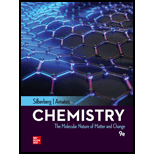
Concept explainers
(a)
Interpretation:
The type of isomerism exhibited by
Concept introduction:
Coordination number:
The coordination number is the number of ligand atoms bonded directly to the central metal ion in a complex ion.
Geometry of coordination compounds: The study of geometry of the coordination compound helps in understanding the physical and chemical property of the compound.
Stereoisomer: The same molecular formula but different with the arrangements of atoms around the metal ion. The Ligands are arranged differently in coordination compounds.
Geometric isomers: stereoisomers that cannot be interconverted without breaking the
Optical isomers: Optical isomers are non-superimposable mirror images.
Plane-polarized light: Light that oscillates in a single plane.
(b)
Interpretation:
The type of isomerism exhibited by
Concept introduction:
Coordination number:
The coordination number is the number of ligand atoms bonded directly to the central metal ion in a complex ion.
Geometry of coordination compounds: The study of geometry of the coordination compound helps in understanding the physical and chemical property of the compound.
Stereoisomer: The same molecular formula but different with the arrangements of atoms around the metal ion. The Ligands are arranged differently in coordination compounds.
Geometric isomers: stereoisomers that cannot be interconverted without breaking the chemical bonds.
Optical isomers: Optical isomers are non-superimposable mirror images.
Plane-polarized light: Light that oscillates in a single plane.
(c)
Interpretation:
The type of isomerism exhibited by
Concept introduction:
Coordination number:
The coordination number is the number of ligand atoms bonded directly to the central metal ion in a complex ion.
Geometry of coordination compounds: The study of geometry of the coordination compound helps in understanding the physical and chemical property of the compound.
Stereoisomer: The same molecular formula but different with the arrangements of atoms around the metal ion. The Ligands are arranged differently in coordination compounds.
Geometric isomers: stereoisomers that cannot be interconverted without breaking the chemical bonds.
Optical isomers: Optical isomers are non-superimposable mirror images.
Plane-polarized light: Light that oscillates in a single plane.
Want to see the full answer?
Check out a sample textbook solution
Chapter 23 Solutions
CHEMISTRY:MOLECULAR...(LL)-W/CONNECT
- Provide the reagents for the following reactions.arrow_forwardIf I have 1-bromopropene, to obtain compound Z, I have to add two compounds A1 and A2. Indicate which compounds are needed. P(C6H5)3arrow_forwardDraw the major product of this reaction. Ignore inorganic byproducts. Assume that the water side product is continuously removed to drive the reaction toward products. O CH3CH2NH2, TSOH Select to Draw >arrow_forward
- Indicate the products obtained by reacting fluorobenzene with a sulfonitric mixture.arrow_forwardIf I have 1-bromopropene, to obtain compound A, I have to add NaOH and another compound. Indicate which compound that would be. C6H5 CH3arrow_forwardIf I have 1-bromopropene and I want to obtain (1,1-dipropoxyethyl)benzene, indicate the compound that I should add in addition to NaOH.arrow_forward
- Draw the major product of this reaction. Ignore inorganic byproducts. Ο HSCH2CH2CH2SH, BF3 Select to Draw I Submitarrow_forwardFeedback (7/10) Draw the major product of this reaction. Ignore inorganic byproducts. Assume that the water side product is continuously removed to drive the reaction toward products. Incorrect, 3 attempts remaining Ο (CH3CH2)2NH, TSOH Select to Draw V N. 87% Retryarrow_forwardIf I want to obtain (1,1-dipropoxyethyl)benzene from 1-bromopropene, indicate the product that I have to add in addition to NaOH.arrow_forward
 ChemistryChemistryISBN:9781305957404Author:Steven S. Zumdahl, Susan A. Zumdahl, Donald J. DeCostePublisher:Cengage Learning
ChemistryChemistryISBN:9781305957404Author:Steven S. Zumdahl, Susan A. Zumdahl, Donald J. DeCostePublisher:Cengage Learning ChemistryChemistryISBN:9781259911156Author:Raymond Chang Dr., Jason Overby ProfessorPublisher:McGraw-Hill Education
ChemistryChemistryISBN:9781259911156Author:Raymond Chang Dr., Jason Overby ProfessorPublisher:McGraw-Hill Education Principles of Instrumental AnalysisChemistryISBN:9781305577213Author:Douglas A. Skoog, F. James Holler, Stanley R. CrouchPublisher:Cengage Learning
Principles of Instrumental AnalysisChemistryISBN:9781305577213Author:Douglas A. Skoog, F. James Holler, Stanley R. CrouchPublisher:Cengage Learning Organic ChemistryChemistryISBN:9780078021558Author:Janice Gorzynski Smith Dr.Publisher:McGraw-Hill Education
Organic ChemistryChemistryISBN:9780078021558Author:Janice Gorzynski Smith Dr.Publisher:McGraw-Hill Education Chemistry: Principles and ReactionsChemistryISBN:9781305079373Author:William L. Masterton, Cecile N. HurleyPublisher:Cengage Learning
Chemistry: Principles and ReactionsChemistryISBN:9781305079373Author:William L. Masterton, Cecile N. HurleyPublisher:Cengage Learning Elementary Principles of Chemical Processes, Bind...ChemistryISBN:9781118431221Author:Richard M. Felder, Ronald W. Rousseau, Lisa G. BullardPublisher:WILEY
Elementary Principles of Chemical Processes, Bind...ChemistryISBN:9781118431221Author:Richard M. Felder, Ronald W. Rousseau, Lisa G. BullardPublisher:WILEY





